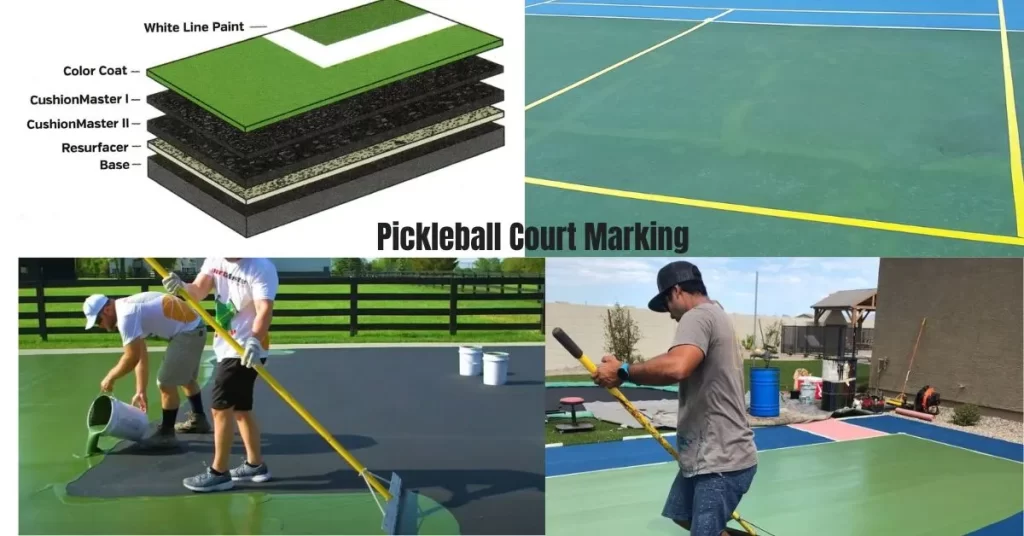
Pickleball is one of the fastest-growing sports in North America. This paddle sport combines elements of tennis, badminton, and ping pong. Play it indoors or outdoors on a badminton-sized court with a slightly modified tennis net. Understand the complicated workings of Pickleball Court Marking, a must-have resource for comprehending the rules.
As pickleball gains popularity, more public parks, recreation centers, schools, and backyards are looking to add pickleball courts. However, properly marking a pickleball court requires some special considerations. In this guide, we’ll cover everything you need to know about pickleball court marking and lining to create regulation-sized courts that are ready for play.
Pickleball Court Dimensions
Chapters
ToggleA regulation pickleball court is 20’ x 44’ for both singles and doubles play. The court is the same size as a doubles badminton court. Here are the official dimensions:
- The court is 20 feet wide
- The court is 44 feet long
- The net hangs at 36 inches at the sidelines and 34 inches in the middle
- The non-volley zone is 7 feet from the net on each side
The net divides the court in half lengthwise. There are also non-volley zones on each side of the net, extending 7 feet back from the net. It’s important to precisely measure and mark the court according to the official dimensions.
Pickleball Court Marking Guidelines
When setting up a new pickleball court, there are some guidelines to follow for proper court marking:
- Use 2-4 inch wide pickleball court marking tape for the baselines, sidelines, and non-volley zone lines.
- The lines should be between 1-2 inches wide.
- Mark the lines in a bright, high-visibility color like white, yellow, or orange.
- The lines must be straight and accurately measured.
- Non-volley zone lines should be a contrasting color to make them stand out.
For portable or temporary courts, you can use temporary pickleball court lines made from tape or chalk. This allows you to set up courts almost anywhere there’s a flat surface.
Pickleball Court Marking Equipment
To get those crisp, straight permanent lines on your pickleball court, you’ll need the right equipment. Here are some must-have supplies:
- Tape measure
- Carpenters square
- Pickleball court marking kit
- Paint brush
- Exterior line paint (acrylic latex)
- Paint roller and tray
- Pickleball court marking tape (for temporary lines)
There are also complete pickleball court marker kits that provide everything you need for court setup in one package. Look for a kit that includes tape measures, chalk line reels, striping tape, and paint. The Franklin pickleball court marker kit is one good option.
For temporary lines, opt for a wider pickleball court marking tape that will stay in place on asphalt or concrete. Chalk line reels with powdered chalk or chalk spray paint also work well for temporary markings.
How to Mark a Pickleball Court
Once you have the proper equipment, here are the step-by-step instructions for marking new pickleball courts:
- Measure the court area and mark the court boundary lines first. Use spray chalk or tape.
- Mark the center line that will divide the two halves of the court lengthwise. Ensure it’s perfectly straight using a chalk line reel.
- Mark the non-volley zone lines parallel to the net on each side, 7 feet back from the net. They should be noticeably different from the other court lines.
- Mark the service court boxes on each side of the net within the boundaries of the non-volley zones.
- Check all measurements twice before painting permanent lines. Adjust tape lines as needed.
- Apply two coats of exterior acrylic paint for permanent pickleball court lines.
- Allow the paint to fully dry before playing on the new court.
With the right preparation and tools, you can create regulation-sized pickleball courts ready for hours of play on driveways, in basements, parks, gyms and more. Accurate court markings are critical for gameplay. Now get out there and start playing this fun paddle sport.
FAQs
While it’s possible for enthusiasts to mark their own courts, seeking professional assistance ensures accuracy and adherence to regulations, guaranteeing a top-notch playing surface.
Avoid using regular paint; instead, opt for specialized court marking paints designed for durability and adherence to specific measurements, ensuring a professional finish.
The frequency of refreshing court markings depends on usage and weather conditions. Regular inspections and touch-ups are advisable to maintain the court’s integrity.
Yes, you can mark a pickleball court on various surfaces, including asphalt and concrete. Each surface demands specific considerations for optimal results.
Sharing is caring!

Pingback: USA pickleball rules: Scoring | Serving | Court Dimensions